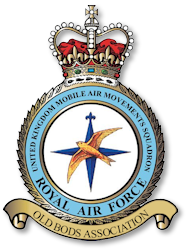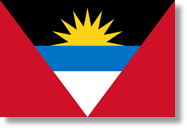
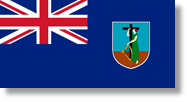

On the morning of Tuesday 1 August 1995, the peace and quiet of the Foreign Aircraft Movements section was interrupted by a telephone summons from MAMS Ops. FS Clive Bishop had summoned FS Bruce Oram for a cup of tea and a chat, suspicious or what?
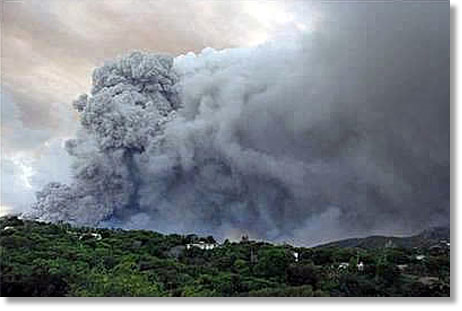
The chat turned out to be an offer of a task to the Caribbean, more specifically, Antigua. The history behind it, was the fact that the volcano on the island of Montserrat was beginning to steam and billow forth small amounts of ash, which according to those in the know precedes the chances of eruption. the previous eruption of this volcano was during the 1600s, which proved to be rather a violent affair.
The team was to be comprised of 4 persons, myself and SACs Andy Walton, Neil Huggard and Paul Hunt, who began immediately to congregate all the equipment that they may need for whatever they may move whilst away on task - the 'beloved Tirfor', lightweight 'portable' scales, etc.
The team was to be comprised of 4 persons, myself and SACs Andy Walton, Neil Huggard and Paul Hunt, who began immediately to congregate all the equipment that they may need for whatever they may move whilst away on task - the 'beloved Tirfor', lightweight 'portable' scales, etc.
The team brief was, as expected, remarkably short as there was virtually no information forthcoming, being a short notice 'spec' task! The team of 4 reported the following day at the prescribed time and proceeded to transport themselves, their equipment and 2 RAFP personnel to the aircraft.
During the start up, all of a sudden we heard one engine wind down, yes, you've guessed it - 'u/s'. After a lot of discussion we were told we had a frame change, and as we wanted to get going we decided to get started straight away. The load was 4 pallets of compo so it didn't take too long, but what a good start to a trip.
During the start up, all of a sudden we heard one engine wind down, yes, you've guessed it - 'u/s'. After a lot of discussion we were told we had a frame change, and as we wanted to get going we decided to get started straight away. The load was 4 pallets of compo so it didn't take too long, but what a good start to a trip.
Having taken off, experienced a night stop in Lajes and a flag stop in Bermuda, we finally arrived in the holiday island of Antigua. On arrival we were met by Flight Lieutenant Chris Ford from 47 Sqn (SF), who briefed the team on exactly what they would be doing over the next few days. This turned out to be 3 trips a day, back and forth to Montserrat, carrying at first compo rations, and afterwards anything we were asked to move. The first task was to transfer up to 20,000 lbs of palletised rations from our recently arrived aircraft, to the awaiting flat floor in-theatre Mk 1, which we would be getting to know particularly well in the next few days.
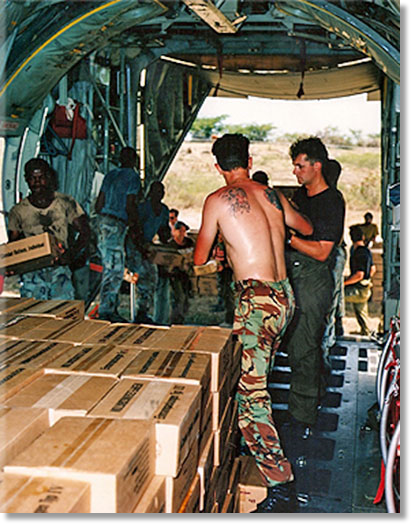
The next 2 good pieces of news we received was that the forklift was going to be busy on 3 other aircraft for at least 4 hours, and the local army assistance wasn't due to arrive until tomorrow!! Using roller off the aircraft, as well as Cpl Ginge Riches, who was travelling route on the aircraft and a lot of sweat, emerging sense of humour, and in my case a few muscles that hadn't been tested for a while, we transferred it to the other aircraft. Having netted the load and cleared up our arrival aircraft, we proceeded down to the Hotel for our first of a few wind-down beers.
The next day, on arrival at the aircraft parking area, we were to discover a parked DS Air Cargo Boeing 707. It had been offloaded, and its 10 pallets of ration packs from Germany, blankets and pillows were awaiting breaking down. Whilst 2 of the team stayed to break down the pallet along with the local army labour force. The other 2 members of the team travelled with the aircraft to supervise the offload at Montserrat (soon to be a standard operating practice).
The approach to the short runway at Montserrat is quite spectacular, flying above the surf, just prior to landing. After arrival and during the offload, the locals kept showing us where the volcano was smoking. Behind the airport buildings and approximately 20-30 miles away the smoke from the volcano could be clearly seen. The offload was complete, the flight back to Antigua went via the area of the volcano, where the ash slides into the sea were very visible, and the smell of sulphur was everywhere.
The approach to the short runway at Montserrat is quite spectacular, flying above the surf, just prior to landing. After arrival and during the offload, the locals kept showing us where the volcano was smoking. Behind the airport buildings and approximately 20-30 miles away the smoke from the volcano could be clearly seen. The offload was complete, the flight back to Antigua went via the area of the volcano, where the ash slides into the sea were very visible, and the smell of sulphur was everywhere.
On arrival back at Antigua the onload of another 20K of rations took place, and that and another load went to the other end of our lift. We also learned that 2 USAF C141 aircraft were due to arrive later that day and the next, carrying 10 pallets each of tents and emergency water bladders. The aircraft arrived back from its last run of the day and was loaded ready for the first run the next day.
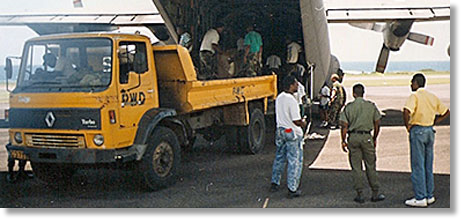
During the night the first of the C141 aircraft had arrived, and the offloaded pallets were awaiting us upon our arrival at the parking area. Just looking at them made us realise that this was where the real hard work was just about to begin.
The water bladders alone weighed approximately 450lbs each, and were like wrestling with 2 people just to get them into position on the aircraft. The rest of the C141 load was marquee type tentage, 'like a boy scout's nightmare'. This, and the load from the other C141, plus another load of blankets, cots and pillows from the 707 was to form the basis of every load to Montserrat, up until 8 August when everything had been transported to the island.
The water bladders alone weighed approximately 450lbs each, and were like wrestling with 2 people just to get them into position on the aircraft. The rest of the C141 load was marquee type tentage, 'like a boy scout's nightmare'. This, and the load from the other C141, plus another load of blankets, cots and pillows from the 707 was to form the basis of every load to Montserrat, up until 8 August when everything had been transported to the island.
We were expecting to receive the news that we were to fly home that day, but HQ 38 Group decided to delay our departure until 10 August. This may have been something to do with the news filtering from Montserrat that more tremors had been felt during the day. The 35 hour rest by the pool was much appreciated by all, I can assure you.
